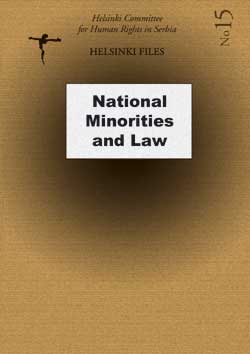FEDERAL LAW ON PROTECTION OF THE RIGHTS AND FREEDOMS OF NATIONAL MINORITIES
FEDERAL LAW ON PROTECTION OF THE RIGHTS AND FREEDOMS OF NATIONAL MINORITIES
Author(s): Author Not Specified
Subject(s): Education, Law, Constitution, Jurisprudence, Civil Law, Human Rights and Humanitarian Law, State/Government and Education, Inter-Ethnic Relations, Ethnic Minorities Studies
Published by: Helsinški odbor za ljudska prava u Srbiji
Keywords: Serbia; federal law; rights and freedoms; national minorities; ethnicity; education; language; high school; underdeveloped regions; state holidays; museum of genocide;
Summary/Abstract: By signing the Framework Convention on the Protection of National Minorities the FRY took on the commitment to ensure to members of national minorities, within its legal system, the minimum of rights and standards of protection envisaged by the Framework Protection. In line with the aforementioned the FRY passed the Law on Protection of Rights and Freedoms of National Minorities which took force on 7 March 2002. A public debate during which many criticisms and praises had been voiced preceded the promulgation of that Act. They contributed to a vast improvement of the text of Act. But the latter is still full of serious shortcomings: The basic shortcoming of this Act is its failure to ensure efficient legal remedies for the protection of minority rights. Every member of a national minority has the right to lodge a complaint with the court for compensation of damage incurred by violation of a minority right either at the hands of state bodies or a private person. But in practice such complaints are rarely lodged because members of national minorities lack faith in the judicial bodies and also dodge public exposure fearing that it might hurt their status. Added to that the Act envisages a possibility of appeals to the Constitutional Court by the Federal Ministry of National and Ethnic Communities and National Councils of National Minorities. Having in mind the fact that such appeals were rarely filed, possibly due to conditions thereof, it is very likely that the provision of Article 23, paragraph 2 shall not contribute to ensuring a genuine, efficient, legal protection of minority rights. The Act does not envisage the introduction of Ombudsman for National Minorities as an independent institution for protection of rights of national minorities, although the efficiency of this institution was confirmed internationally as a form of control of state bodies in their duties relating to adequate protection of those rights. Ombudsman for National Minorities would have an authority to monitor implementation of laws and politics with respect to the rights and freedoms of national minorities, to collect and register complaints and institute judicial proceedings for the protection of rights of national minorities. Possible shortcomings of this Act are the status and rights of "small" minorities. Definition of national minorities, notably, "national minority is a group of citizens of the FRY, whose number is sufficiently representative" indicates that the exercise of minority rights is conditioned by the number of members of a minority. This in turn implies that the right of members of so-called "small" national minorities to exercise their rights under the said law may be conditioned. Hence the emergence of the issue of relationship between "bigger" and "smaller" minorities. And finally the Act does not envisage any sanctions for the state bodies (at local, republican and federal level) abusing or breaching the rights of national minorities, or failing to take actions with a view to ensuring full and efficient equality of minorities and the majority people. The latter casts doubt on a genuine intention and readiness of a law-maker to realise what this law nominally envisages and recognises. In further text we shall give an outline or rather a summary of legal provisions which contain discriminating norms or those which enable discrimination in an indirect way.
Book: HELSINŠKE SVESKE №15: National minorities and law
- Page Range: 20-27
- Page Count: 8
- Publication Year: 2002
- Language: English
- Content File-PDF

